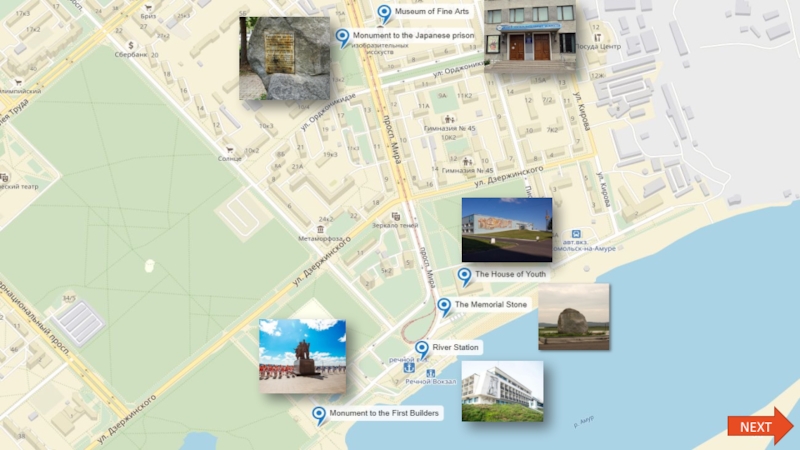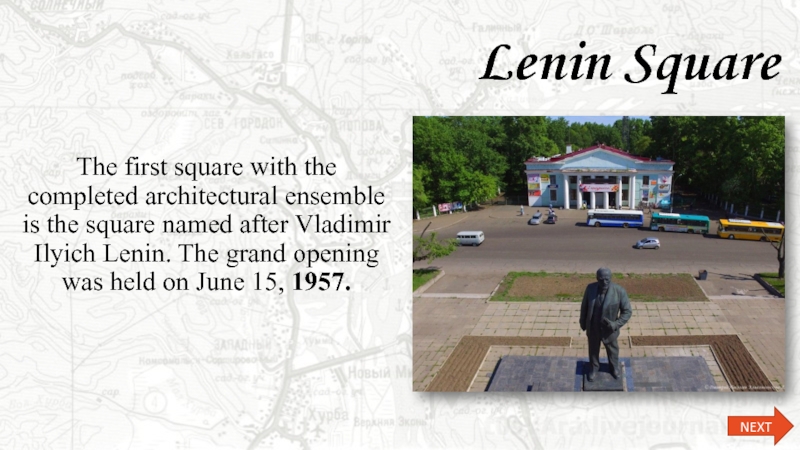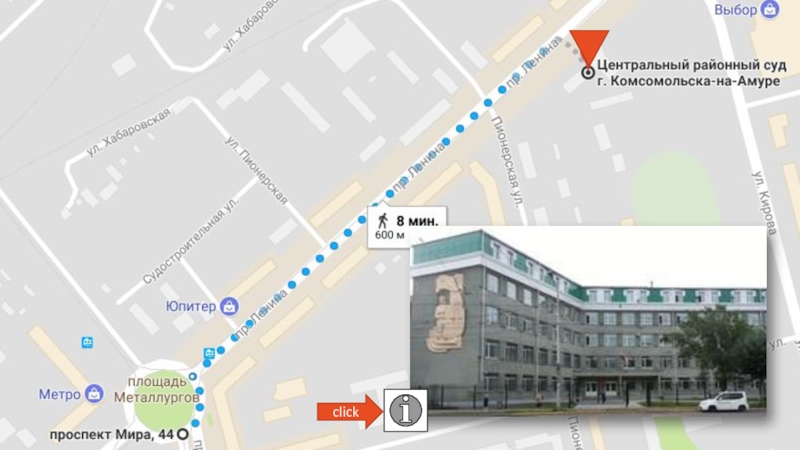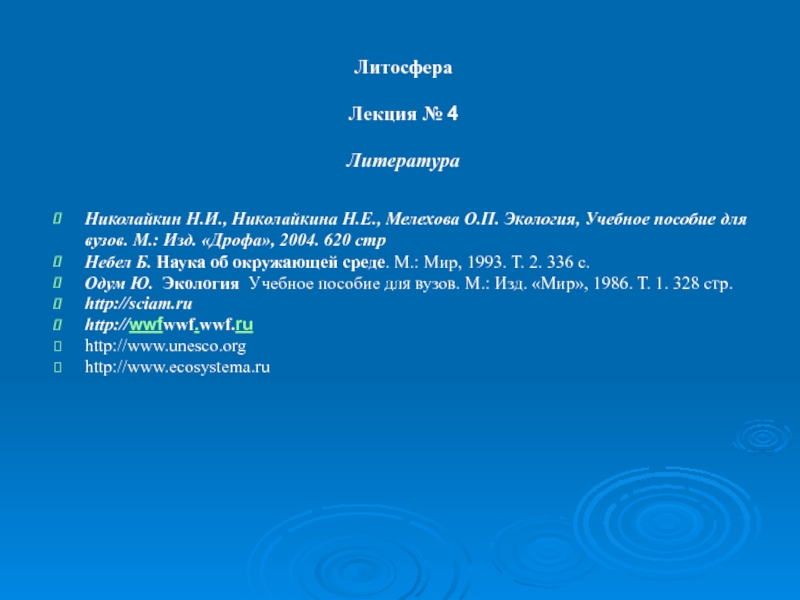- Главная
- Разное
- Дизайн
- Бизнес и предпринимательство
- Аналитика
- Образование
- Развлечения
- Красота и здоровье
- Финансы
- Государство
- Путешествия
- Спорт
- Недвижимость
- Армия
- Графика
- Культурология
- Еда и кулинария
- Лингвистика
- Английский язык
- Астрономия
- Алгебра
- Биология
- География
- Детские презентации
- Информатика
- История
- Литература
- Маркетинг
- Математика
- Медицина
- Менеджмент
- Музыка
- МХК
- Немецкий язык
- ОБЖ
- Обществознание
- Окружающий мир
- Педагогика
- Русский язык
- Технология
- Физика
- Философия
- Химия
- Шаблоны, картинки для презентаций
- Экология
- Экономика
- Юриспруденция
Welcome to our interactive guide tour around Komsomolsk-on-Amur презентация
Содержание
- 1. Welcome to our interactive guide tour around Komsomolsk-on-Amur
- 2. Let’s get started!
- 3. Komsomolsk-on-Amur Komsomolsk-on-Amur is the second largest city of
- 4. NEXT
- 5. NEXT
- 6. finish
- 7. click
- 8. The Memorial Stone The Memorial Stone was
- 10. The Memorial Stone The wooden Church of
- 11. The Memorial Stone In the early
- 12. click
- 13. The House of Youth The House of
- 14. click
- 15. River Station The River station, built upon
- 16. click
- 17. The Monument to the First Builders And
- 18. click
- 19. The Monument to the Japanese prisoners
- 20. click
- 21. The Museum of Fine Arts
- 22. click
- 23. The Palace of Culture DK ZLK is
- 24. click
- 25. Gubernator’s technical school The first house which
- 26. click
- 27. N. Ostrovsky library The first city library
- 28. click
- 29. Orthodox cathedral of the Kazan Icon of
- 30. click
- 31. The Present from Jiamusi International ties in
- 32. click
- 33. Lenin Square The first square with the
- 34. Lenin Statue Vladimir Ilyich Lenin Statue is
- 35. House with a spire The unofficial symbol
- 36. click
- 37. Metallurgov Square Metallurgov Square is the
- 38. click
- 39. The House of Justice It
- 40. click
- 41. Komsomolskoe Roadway & the Silinka River
- 42. click
- 43. Pobedy Avenue In December1985 Odesskaya Street in
- 44. click
- 45. School of Art № 11 In 1936
- 46. Welcome to Komsomolsk-on-Amur! home
Слайд 1Welcome to our interactive guide tour around Komsomolsk-on-Amur!
This interactive guide is
On our way we will visit many places of interest such as the Memorial Stone, the House of Youth, the Monument to the First builders, the Monument to the Japanese Prisoners of War and many others.
These sights will tell you about the history of the city, its development and growth.
Слайд 3Komsomolsk-on-Amur
Komsomolsk-on-Amur is the second largest city of Khabarovsk krai and the fourth
Слайд 8The Memorial Stone
The Memorial Stone was unveiled on June, 14, 1967.
In 1848 admiral G.I.Nevelskoy who was the Amur Krai explorer and scientist-navigator set on the expedition on the barque “Baikal”.
As a result it was officially proved that the Amur river was a navigable one and had an access to the Pacific Ocean.
As a strategic waterway it was of great significance for Russia.
NEXT
Слайд 9 The Memorial Stone
One of
They arrived on August, 18, 1860. This date is commonly believed to be the date of the village foundation.
The first resettlers gave the village the name Permskoye-on-Amur. Later on, peasants from the Tambov, the Orel and other provinces located in the central part of our country started to arrive.
NEXT
Слайд 10The Memorial Stone
The wooden Church of the Holy Prophet Elijah built
NEXT
Слайд 11The Memorial Stone
In the early 1930s the USSR Government paid special
It was necessary to fortify Pacific Fleet and air forces. That is why the main aim was the construction of shipbuilding and aircraft-building plants.
On February, 23, 1932 the decision to construct the shipbuilding plant near the village of Permskoye was made. On May, 2 steamers “Kolumb” and “Komintern” and the barge “Clara Zretkin” brought the group of the city first builders to the Amure shore.
On June, 14, 1967 the rocky lump was erected at the sight where the first Komsomol builders had landed. The inscription runs as follows:
“Here on May, 10, 1932 the first Komsomol members, builders of the city, landed ashore”.
Слайд 13The House of Youth
The House of Youth was designed by Moscow
The right to cut the entrance tape of the country’s first Komsomol House of Youth was granted to the honorary guest of our city, the first cosmonaut Y.A.Gagarin.
The House of Youth was the first recreational center of such a type in the city.
There is a concert hall with 600 seats, the city’s first swimming pool, an exhibition hall, a dance hall and a café.
Слайд 15River Station
The River station, built upon the project by the Leningrad
It was designed to look like a ship from the Amur's side. In its construction you can discern decks, a bow, a stern, a funnel and a gangway.
Its three wharfs mark the level of the Amur within ten meters.
Слайд 17The Monument to the First Builders
And on this high pedestal you
A young builder, probably a Komsomol leader, is ahead. There is a girl next to him. Near them you can see a farm worker with a shovel in his hands and a soldier with a greatcoat over his shoulders. The young land-surveyor closes the sculptural group. He turned his head back as if to call those who must follow the First builders of the city.
There is a guitar among the things the builders of the new city have taken with them. The guitar symbolizes the romantic spirit of that time to build a “model” city - a new future, carrying the Soviet dream to the Far east.
The monument embodies the style of that time, which is distinguished by stylization, romantic elation, dynamism.
The Monument to the First Builders was erected on the Embankment in the year of Komsomolsk-on-Amur 50th anniversary.
Слайд 19 The Monument to the Japanese prisoners of war
Over 640 thousand
The Japanese people worked at the factories, stored up timber for the city, unloaded the cars, made furniture, and built houses. There are more than 423 objects built by the Japanese prisoners of war.
Komsomolsk-on-Amur is the first city in the Russian Federation that collected and systematized the data about the Japanese war-prisoners. In the summer of 1990 the former Japanese prisoners of war arrived in Komsomolsk and appealed to the city authorities to put a memorial for all the Japanese prisoners of war who died in the Komsomolsk region in 1945-1949.
The author of the installation is the Komsomolsk sculptor A. P. Smirnov. The stone for it was brought from Solnechny district.
On October 5, 1991 it was erected on Mira Avenue near the city’s first hotel "Amur", built by the Japanese prisoners of war.
Слайд 21The Museum of Fine Arts
The museum moved to the building on
On the ground floor is a hall for temporary exhibitions. Upstairs one can find a nice collection of indigenous art including ritual sculptures, clothing, utensils and ornaments from the Narnaii's and other Amur estuary aboriginal peoples.
In 1993, the museum hosted an exhibition of paintings by Japanese artist Yoshida Isamu. Another Japanese artist Tsutomu Miyamoto has been exhibiting his works in this museum for many years. Both are former Japanese prisoners of war.
Слайд 23The Palace of Culture
DK ZLK is the first Palace of Culture
In 1944 the central part of the Palace was erected. In the 1960s, the Palace was rebuilt according to the project by the Leningrad architects A. Y.Gladkikh, S.I.Sokolov, B.I.Sretensky.
The construction of the modern building was completed in 1975. The Palace of Culture has a hall for 865 people, a lecture hall for 400 seats, a library with reading rooms, a dance hall, a cafe, rooms for club activities and others. The right wing of the Palace of Culture houses the Sports Centre with two swimming pools, a sports hall and a sauna.
Слайд 25Gubernator’s technical school
The first house which appeared on Mira Avenue was
The building of the modern technical school was constructed in 1939. And right after that the technical school got a new name – “Shipbuilding college”. It was convicts who build the school.
Слайд 27N. Ostrovsky library
The first city library was opened in 1936 in
N.Ostrovsky is a Soviet writer, the author of the novel “How the Steel Was Tempered”.
The sculpture is made of copper and is 3.80 meters high. The height of the pedestal, covered with red marble is 4 meters.
Слайд 29Orthodox cathedral of the Kazan Icon of the God’s Mother
The opening
The Cathedral with a cross is 29 meters long, 19 meters wide and 28 meters high.
Слайд 31The Present from Jiamusi
International ties in culture, education and sports are
International ties connect Komsomolsk-on-Amur with the cities of Jiamusi (China), Kamo (Japan) and Weinan (China since 2016).
At the intersection of Pervostroiteley Avenue and Lenin Avenue you can see an unusual installation, the gift from the city of Jiamusi (Komsomolsk-on-Amur sister city).
The composition consists of 2 parts: a round platform as a symbol of the universe and red tongues of flame as a symbol of luck, sun, active work and energy.
The opening ceremony took place on July 20, 2007.
Слайд 33Lenin Square
The first square with the completed architectural ensemble is the
NEXT
Слайд 34Lenin Statue
Vladimir Ilyich Lenin Statue is set on the 5-meter pedestal.
Слайд 35House with a spire
The unofficial symbol of Komsomolsk-on-Amur is a “house
The building is under the state protection and one of the city’s landmarks.
Слайд 37Metallurgov Square
Metallurgov Square is the very centre of the city.
Слайд 39The House of Justice
It was built in 1976. The head of
There were several attempts to remove the bas-relief from the wall, but it turned to be impossible, as each of twenty fragments goes 60 centimeters deep into the wall.
Слайд 41Komsomolskoe Roadway &
the Silinka River
The longest roadway in Komsomolsk-on-Amur is
Two construction sites, “City” and “Dzemgi”, were connected by the roadway. Now the official names of the city’s two districts are Central and Leninsky districts of Komsomolsk-on-Amur.
The distance between them is12km and they are divided by the river Silinka, which flows into the Amur River.
Almost untouched forest was left on the left bank of the Silinka River along Komsomolskoe roadway. This area got the nickname “the lungs of the city”.
Silinka’s forest is a root cedar-broad-leaved forest with an admixture of spruce, fir, and yew. The average age of trees is 80-100 years.
Слайд 43Pobedy Avenue
In December1985 Odesskaya Street in Lenin District was renamed as
The Victory Memorial on Pobedy Avenue was opened on May7th, 2005. There is an inscription on the memorial plaque fixed on the Steles: " In honor of the 60th anniversary of the victory in the Great Patriotic War (1941-1945)
(from Komsomolsk-on-Amur organizations and enterprises)“.
Слайд 45School of Art № 11
In 1936 the city’s first evening school
Now it’s a School of Art where students master different kinds of art exhibiting their creations at local, state and international competitions.



















































